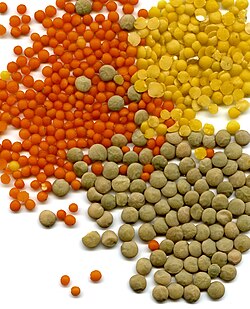Protein (nutrient)

Proteins are essential nutrients for the human body. They are one of the building blocks of body tissue, and can also serve as a fuel source. As fuel, proteins contain 4 kcal per gram, just like carbohydrates and unlike lipids, which contain 9 kcal per gram.
Proteins are polymer chains made of amino acids linked together by peptide bonds. In nutrition, proteins are broken down in the stomach during digestion by enzymes known as proteases into smaller polypeptides to provide amino acids for the body, including the essential amino acids that cannot be biosynthesized by the body itself.
Amino acids are found in animal sources such as meats, milk, fish and eggs, as well as in plant sources such as whole grains, pulses, legumes, soy, fruits, nuts and seeds. Vegetarians and vegans can get enough essential amino acids by eating a variety of plant proteins.
Protein functions in body
Protein is a nutrient needed by the human body for growth and maintenance. Aside from water, proteins are the most abundant kind of molecules in the body. Protein can be found in all cells of the body and is the major structural component of all cells in the body, especially muscle. This also includes body organs, hair and skin. Proteins also are utilized in membranes, such as glycoproteins. When broken down into amino acids, they are used as precursors to nucleic acid, co-enzymes, hormones, immune response, cellular repair and molecules essential for life. Finally, protein is needed to form blood cells.
Protein function in exercise
Proteins are one of the key nutrients for success in terms of sports. Amino acids, the building blocks of proteins, are used for building tissue, including muscle, as well as repairing damaged tissues. Proteins usually only provide a small source of fuel for the exercising muscles, being used as fuel typically only when carbohydrates and lipid resources are low.
Sources of Protein
A wide range of foods are a source of protein. The best combination of protein sources depends on the region of the world, access, cost, amino acid types and nutrition balance, as well as acquired tastes. Some foods are high in certain amino acids, but their digestibility and the anti-nutritional factors present in these foods make them of limited value in human nutrition. Therefore, one must consider digestibility and secondary nutrition profile such as calories, cholesterol, vitamins and essential mineral density of the protein source. On a worldwide basis, plant protein foods contribute over 60 percent of the per capita supply of protein, on average. In North America, animal-derived foods contribute about 70 percent of protein sources.
Whole grains and cereals are another source of proteins. Examples of food staples and cereal sources of protein, are (in no particular order) buckwheat, oats, rye, millet, maize (corn), rice, wheat, spaghetti, bulgar, sorghum, amaranth, and quinoa.
Vegetarian sources of proteins include legumes, nuts, seeds and fruits. Legumes (pulses), have higher concentrations of amino acids and are more complete sources of protein than whole grains and cereals. Examples of vegetarian foods with higher protein concentrations include soybeans, lentils, kidney beans, white beans, mung beans, chickpeas, cowpeas, lima beans, pigeon peas, wing beans, almonds, Brazil nuts, cashews, pecans, walnuts, cotton seeds, pumpkin seeds, sesame seeds, and sunflower seeds.
Food staples that are poor sources of protein include roots and tubers such as yams, cassava and sweet potato. Plantains, another major staple, are also a poor source of essential amino acids. Fruits, while rich in other essential nutrients, are another poor source of amino acids per 100 gram consumed. The protein content in roots, tubers and fruits is between 0 and 2 percent. Food staples with low protein content must be complemented with foods with complete, quality protein content for a healthy life, particularly in children for proper development.
A good source of protein is often a combination of various foods, because different foods are rich in different amino acids.
Animal sources of protein
Plant sources of protein
See also
- reference source
Find recipes that contain 'Protein (nutrient)'
#fruits #legumes #wholegrains #nuts #cheese #mungbeans #cowpeas #walnuts #fish #almonds #seeds











